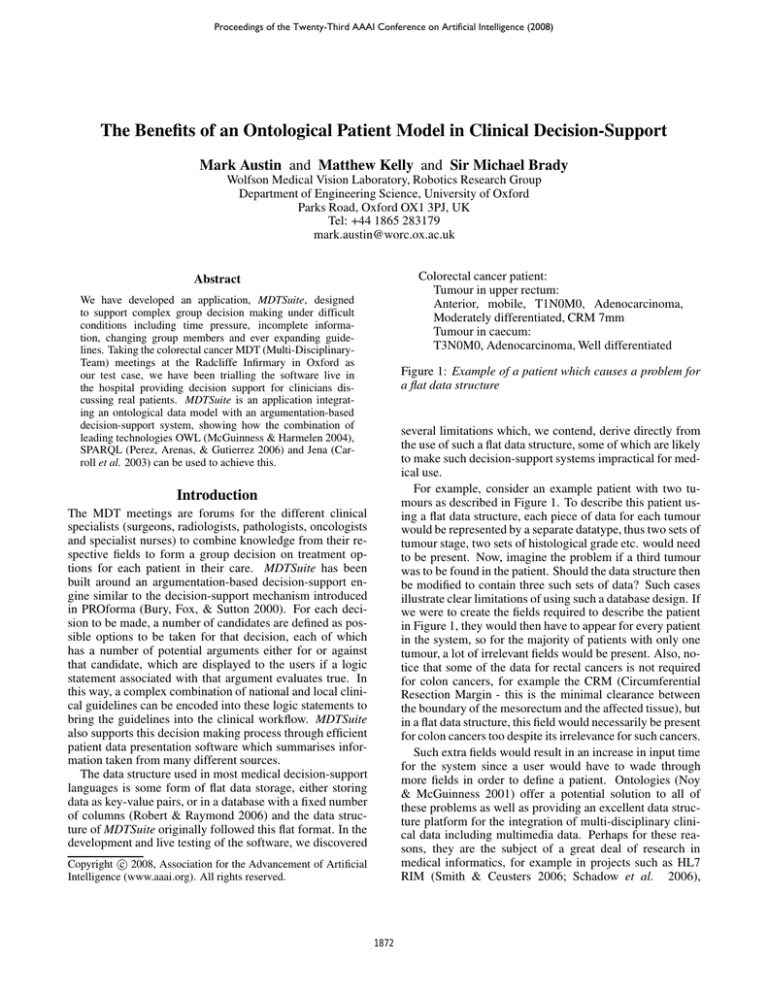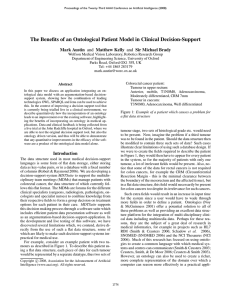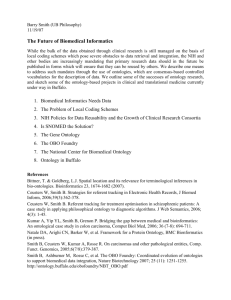
Proceedings of the Twenty-Third AAAI Conference on Artificial Intelligence (2008)
The Benefits of an Ontological Patient Model in Clinical Decision-Support
Mark Austin and Matthew Kelly and Sir Michael Brady
Wolfson Medical Vision Laboratory, Robotics Research Group
Department of Engineering Science, University of Oxford
Parks Road, Oxford OX1 3PJ, UK
Tel: +44 1865 283179
mark.austin@worc.ox.ac.uk
Colorectal cancer patient:
Tumour in upper rectum:
Anterior, mobile, T1N0M0, Adenocarcinoma,
Moderately differentiated, CRM 7mm
Tumour in caecum:
T3N0M0, Adenocarcinoma, Well differentiated
Abstract
We have developed an application, MDTSuite, designed
to support complex group decision making under difficult
conditions including time pressure, incomplete information, changing group members and ever expanding guidelines. Taking the colorectal cancer MDT (Multi-DisciplinaryTeam) meetings at the Radcliffe Infirmary in Oxford as
our test case, we have been trialling the software live in
the hospital providing decision support for clinicians discussing real patients. MDTSuite is an application integrating an ontological data model with an argumentation-based
decision-support system, showing how the combination of
leading technologies OWL (McGuinness & Harmelen 2004),
SPARQL (Perez, Arenas, & Gutierrez 2006) and Jena (Carroll et al. 2003) can be used to achieve this.
Figure 1: Example of a patient which causes a problem for
a flat data structure
several limitations which, we contend, derive directly from
the use of such a flat data structure, some of which are likely
to make such decision-support systems impractical for medical use.
For example, consider an example patient with two tumours as described in Figure 1. To describe this patient using a flat data structure, each piece of data for each tumour
would be represented by a separate datatype, thus two sets of
tumour stage, two sets of histological grade etc. would need
to be present. Now, imagine the problem if a third tumour
was to be found in the patient. Should the data structure then
be modified to contain three such sets of data? Such cases
illustrate clear limitations of using such a database design. If
we were to create the fields required to describe the patient
in Figure 1, they would then have to appear for every patient
in the system, so for the majority of patients with only one
tumour, a lot of irrelevant fields would be present. Also, notice that some of the data for rectal cancers is not required
for colon cancers, for example the CRM (Circumferential
Resection Margin - this is the minimal clearance between
the boundary of the mesorectum and the affected tissue), but
in a flat data structure, this field would necessarily be present
for colon cancers too despite its irrelevance for such cancers.
Such extra fields would result in an increase in input time
for the system since a user would have to wade through
more fields in order to define a patient. Ontologies (Noy
& McGuinness 2001) offer a potential solution to all of
these problems as well as providing an excellent data structure platform for the integration of multi-disciplinary clinical data including multimedia data. Perhaps for these reasons, they are the subject of a great deal of research in
medical informatics, for example in projects such as HL7
RIM (Smith & Ceusters 2006; Schadow et al. 2006),
Introduction
The MDT meetings are forums for the different clinical
specialists (surgeons, radiologists, pathologists, oncologists
and specialist nurses) to combine knowledge from their respective fields to form a group decision on treatment options for each patient in their care. MDTSuite has been
built around an argumentation-based decision-support engine similar to the decision-support mechanism introduced
in PROforma (Bury, Fox, & Sutton 2000). For each decision to be made, a number of candidates are defined as possible options to be taken for that decision, each of which
has a number of potential arguments either for or against
that candidate, which are displayed to the users if a logic
statement associated with that argument evaluates true. In
this way, a complex combination of national and local clinical guidelines can be encoded into these logic statements to
bring the guidelines into the clinical workflow. MDTSuite
also supports this decision making process through efficient
patient data presentation software which summarises information taken from many different sources.
The data structure used in most medical decision-support
languages is some form of flat data storage, either storing
data as key-value pairs, or in a database with a fixed number
of columns (Robert & Raymond 2006) and the data structure of MDTSuite originally followed this flat format. In the
development and live testing of the software, we discovered
c 2008, Association for the Advancement of Artificial
Copyright Intelligence (www.aaai.org). All rights reserved.
1872
then stored in a corporate memory to form part of the patient summary when the patient returns to be rediscussed in
the future. By scanning all the arguments relating to a particular decision, the software generates a property tree of
information which is required to fully describe the patient
instance such that all of the necessary rules for each patient
are evaluated fully. Any of this required data missing at the
time of the meeting is highlighted along with how it might
impact the recommendations and this data can be added on
the fly during the meeting via a pop up input box. Finally
we will show the rule authoring tool provided so that the
users can add new candidates and arguments as well as the
SPARQL logic associated with them, allowing the rulebase
to be maintained and extended by users who need not be
expert programmers.
SNOMED (SNOMED 2006) and the NCI Thesaurus (NCI
2006). Much of this research has focused on using ontologies to create a common language with which medical systems and centres can communicate (Smith & Ceusters 2003;
Ceusters, Smith, & De Moor 2006). However, an ontology
can also be used to create a richer, more complete representation of the domain over which a computer can reason
more effectively in a practical application, providing benefits beyond information integration. This more complete
ontology-based representation enables us to describe the patient in Figure 1 fully, as well as handling even more complicated cases, whilst at the same time maintaining an efficient,
smaller set of inputs for less complex patients. The relationships between data inherent in an ontological data structure
enable an increase in the relevance of input fields such that
only the required fields are displayed for each patient. These
inherent relationships also facilitate a consistency check of
the data capable of reducing the number of human input errors in the system.
References
Bury, J.; Fox, J.; and Sutton, D. 2000. The proforma
guideline specification language: progress and prospects.
Proc First European Workshop, Computer-based Support
for Clinical Guidelines and Protocols.
Carroll, J.; Dickinson, I.; Dollin, C.; Reynolds, D.; Seaborne, A.; and Wilkinson, K. 2003. Jena: Implementing
the semantic web recommendations.
Ceusters, W.; Smith, B.; and De Moor, G. 2006. Ontologybased integration of medical coding systems and electronic
patient records. http://ontology.buffalo.edu/medo/CodingAndEHCR.pdf.
Garrett, J., ed. 2006. Ajax: A New Approach to Web
Applications. http://www.adaptivepath.com/ideas/essays/archives/000385.php.
McGuinness, D., and Harmelen, F. v. 2004. Owl web ontology language overview. W3C Recommendation.
NCI. 2006. Nci thesaurus. http://nciterms.nci.nih.gov.
Noy, N. F., and McGuinness, D. L. 2001. Ontology Development 101.
Perez, J.; Arenas, M.; and Gutierrez, C. 2006. Semantics
and complexity of sparql.
Robert, M. J., and Raymond, J. K. 2006. Electronic medical records and medical research databases can they be synonymous? Business Briefing: US Cardiology.
Schadow, G.; Walker, C.; Mead, N.; and Mead, D. 2006.
The hl7 reference information model under scrutiny. Studies in Health Technology and Informatics Vol 124.
Smith, B., and Ceusters, W. 2003. Towards industrialstrength philosophy: How analytical ontology can help
medical informatics. Interdisciplinary Science Reviews.
Smith, B., and Ceusters, W. 2006. Hl7 rim: An incoherent
standard. Studies in Health Technology and Informatics Vol
124 133138.
SNOMED. 2006. Snomed clinical terms (snomed ct) core
content for the july 2006 release. http://www.snomed.org/snomedct/documents/july 2006 release.pdf.
Ontology-Driven MDTSuite
While we have focused our trial of the software on colorectal cancer, MDTSuite has been written in such a way that the
knowledge base is completely separated from the application, so the software can be converted for use in any group
decision making environment simply by writing a new rulebase. We have authored an OWL colorectal cancer ontology to replace the flat-file patient data model used originally
and refactored the software to handle this model using the
Jena java API. A data-driven, AJAX (Garrett 2006) powered
patient data input form is generated automatically from the
ontology and patient summaries are generated automatically
from the populated patient instances. The logic statements
associated with the arguments are written in the W3C recommended SPARQL query language, and this rulebase can
be created and maintained within the software itself.
The demonstration will take the audience through the
patient journey for a single patient being discussed at the
MDT meetings over several weeks as well as provide an
overview of how the rulebase is authored and maintained,
showing clearly how different disease domains, or even nonmedical domains could be handled. The software is initially
loaded with a disease domain OWL ontology, as well as an
XML file containing the argumentation logic in the form of
SPARQL queries. Patient data is added via the AJAX based
flexible input form before the MDT meeting. During the
meeting, an automatically generated summary of each patient instance is displayed as the patient is discussed, before
the software displays a decision support page showing the
various treatment options (the candidates) and the arguments
for and against each candidate generated by the SPARQL
queries. Recommendations are made for those candidates
with more arguments for than against according to the netsupport algorithm present in PROforma (Bury, Fox, & Sutton 2000). Once the group comes to a decision, the candidate must be selected, and where a non-recommended candidates is selected, a reason for the deviation from guidelines
must be provided. This selection, along with the arguments
which led to that recommendation and any comments, are
1873






